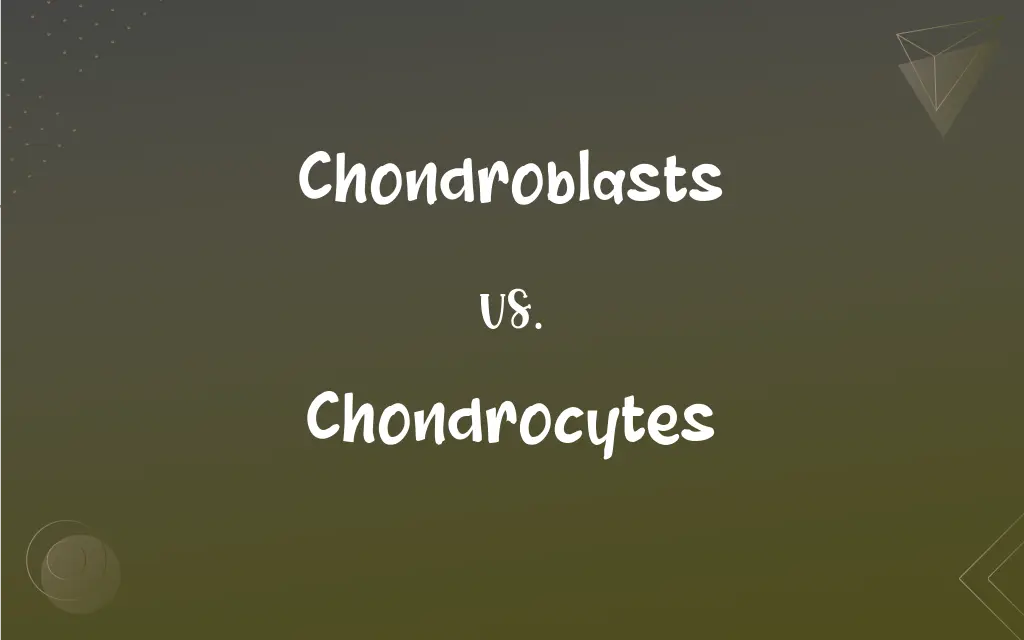Chondroblasts vs. Chondrocytes: What's the Difference?
Edited by Aimie Carlson || By Harlon Moss || Updated on October 28, 2023
Chondroblasts are cartilage-forming cells, while chondrocytes are mature cartilage cells.

Key Differences
Chondroblasts and chondrocytes both play crucial roles in the formation and maintenance of cartilage. Chondroblasts are the progenitor cells found in growing cartilage and are responsible for producing the cartilage matrix. As they secrete this matrix, chondroblasts become encased within it, transitioning into chondrocytes.
In the context of cartilage formation, chondroblasts are the active cells that produce and secrete the components of the cartilage extracellular matrix. As they age and become surrounded by the matrix they've produced, chondroblasts differentiate into chondrocytes. Chondrocytes then become the primary cells in mature cartilage, residing in spaces called lacunae.
It's essential to understand the functional difference between chondroblasts and chondrocytes. While chondroblasts are active in producing the cartilage matrix, chondrocytes are primarily involved in maintaining it. In mature cartilage, chondrocytes can also revert to a chondroblast-like state under certain conditions, highlighting their dynamic nature.
Another noteworthy distinction lies in their location within cartilage. Chondroblasts are typically found in the periphery, especially in growing cartilage, reflecting their active role in matrix production. Chondrocytes, being mature cells, are distributed throughout the cartilage, occupying small cavities known as lacunae.
While both chondroblasts and chondrocytes are vital for cartilage health, they respond differently to certain stimuli. For instance, in osteoarthritis, chondrocytes can undergo abnormal changes, affecting cartilage integrity. Recognizing the distinct roles and behaviors of chondroblasts and chondrocytes is crucial in understanding cartilage biology and related diseases.
ADVERTISEMENT
Comparison Chart
Definition
Progenitor cells producing cartilage matrix.
Mature cells maintaining cartilage matrix.
Stage in Cartilage Formation
Active in early cartilage formation.
Predominant in mature cartilage.
Location
Found mainly at the periphery of growing cartilage.
Reside in lacunae throughout mature cartilage.
Main Function
Produce and secrete cartilage matrix components.
Maintain the cartilage matrix.
Response to Disease
Less involved in diseases like osteoarthritis.
Can undergo abnormal changes in osteoarthritis.
ADVERTISEMENT
Chondroblasts and Chondrocytes Definitions
Chondroblasts
Chondroblasts are precursor cells of cartilage.
The chondroblasts actively produced the matrix during cartilage formation.
Chondrocytes
Chondrocytes can revert to a chondroblast-like state in specific situations.
Under certain stimuli, chondrocytes displayed chondroblast-like characteristics.
Chondroblasts
Chondroblasts produce the cartilage matrix.
Chondroblasts were abundant in the growing regions of the cartilage.
Chondrocytes
Chondrocytes are mature cartilage cells.
Chondrocytes occupied tiny spaces within the firm cartilage structure.
Chondroblasts
Chondroblasts actively secrete components of the extracellular matrix.
The robust activity of chondroblasts led to rapid cartilage formation.
Chondrocytes
Chondrocytes reside in lacunae within the cartilage matrix.
The lacunae provided a niche for the chondrocytes in the cartilage.
Chondroblasts
Chondroblasts are found mainly in growing cartilage.
In younger cartilage regions, chondroblasts were more prevalent.
Chondrocytes
Chondrocytes play a key role in maintaining cartilage health.
Healthy chondrocytes ensured the cartilage remained resilient.
Chondroblasts
Chondroblasts differentiate into chondrocytes once encased in the matrix.
As they secreted the matrix, chondroblasts transformed into chondrocytes.
Chondrocytes
Chondrocytes are involved in cartilage responses to diseases like osteoarthritis.
In osteoarthritic cartilage, chondrocytes exhibited abnormal behaviors.
Chondroblasts
Plural of chondroblast
Chondrocytes
Plural of chondrocyte
FAQs
Where are chondroblasts primarily located in cartilage?
Chondroblasts are mainly found at the periphery of growing cartilage.
What do chondrocytes occupy within cartilage?
Chondrocytes reside in small cavities known as lacunae.
What are chondroblasts?
Chondroblasts are progenitor cells that produce the cartilage matrix.
Which cells are more involved in cartilage diseases like osteoarthritis?
Chondrocytes play a more significant role in conditions like osteoarthritis.
How do chondroblasts contribute to cartilage formation?
Chondroblasts actively produce and secrete components of the cartilage matrix.
Is the presence of chondrocytes a sign of mature cartilage?
Yes, chondrocytes predominantly reside in mature cartilage.
Are chondrocytes found in the periphery of growing cartilage?
No, chondroblasts are typically found at the periphery, with chondrocytes inside the mature cartilage.
Which cells are more abundant in young cartilage?
Chondroblasts are more prevalent in younger, growing regions of cartilage.
Can chondrocytes revert back to a chondroblast-like state?
Yes, under certain conditions, chondrocytes can exhibit chondroblast-like behaviors.
Can chondrocytes produce the cartilage matrix?
While chondrocytes primarily maintain the matrix, they can revert to a matrix-producing state under specific conditions.
What do chondroblasts differentiate into?
Chondroblasts differentiate into chondrocytes as they become encased in the cartilage matrix.
Is matrix production the primary role of chondrocytes?
No, while chondrocytes can produce matrix under specific conditions, their primary role is maintenance.
How do chondrocytes differ from chondroblasts?
Chondrocytes are mature cartilage cells, while chondroblasts are active in matrix production.
Do chondroblasts mature into chondrocytes?
Yes, as chondroblasts produce the matrix, they differentiate into chondrocytes.
What happens to chondroblasts as cartilage matures?
As cartilage matures, chondroblasts become encased in the matrix and differentiate into chondrocytes.
Do chondrocytes have a role in early cartilage formation?
No, chondrocytes are primarily involved in maintaining mature cartilage.
What's the main function of chondroblasts in growing cartilage?
In growing cartilage, chondroblasts actively produce the cartilage matrix.
Are chondroblasts involved in maintaining cartilage health?
Chondroblasts are primarily involved in matrix production, with chondrocytes maintaining cartilage health.
How do chondroblasts and chondrocytes respond to disease?
While chondroblasts are less involved, chondrocytes can undergo abnormal changes in diseases like osteoarthritis.
Are chondrocytes actively involved in matrix production?
No, chondrocytes mainly maintain the matrix, while chondroblasts produce it.
About Author
Written by
Harlon MossHarlon is a seasoned quality moderator and accomplished content writer for Difference Wiki. An alumnus of the prestigious University of California, he earned his degree in Computer Science. Leveraging his academic background, Harlon brings a meticulous and informed perspective to his work, ensuring content accuracy and excellence.
Edited by
Aimie CarlsonAimie Carlson, holding a master's degree in English literature, is a fervent English language enthusiast. She lends her writing talents to Difference Wiki, a prominent website that specializes in comparisons, offering readers insightful analyses that both captivate and inform.































































